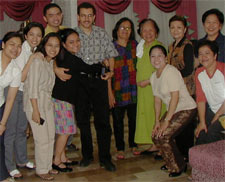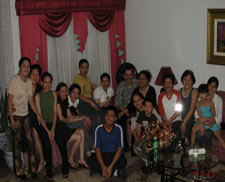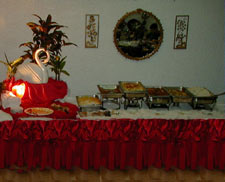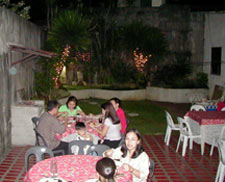| Beliefs, traditions,
facts, folklore, superstitions, etc... |
|
Filipinos, like many other cultures
of today are unique not only because of their cultures, traditions,
religions but because Filipinos still adhere to numerous widely-held
folk beliefs that have no scientific or logical basis but maybe
backed-up by some past experiences (yet can be dismissed as mere
coincidence). Some are still practiced to this day primarily because
of 'there's nothing to lose if we comply' attitude while the others
are totally ignored for it seemed downright ridiculous. According
to the ancestors, some of them were true. Whenever they see or
feel something they always give meaning to it. They feel that
grave circumstances could fall upon them if they didn't follow
or obey these beliefs. The following are some examples of the
superstitions:
|
- Brides shouldn't try on her wedding dress before the wedding
day or the wedding will not push through.
- Knives and other sharp and pointed objects are said to be
a bad choice for wedding gifts for this will lead to a broken
marriage.
- Giving arinola (chamberpot) as wedding gift is believed to
bring good luck to newlyweds.
- Altar-bound couples are accident-prone and therefore must
avoid long drives or traveling before their wedding day for
safety.
- The groom who sits ahead of his bride during the wedding
ceremony will be a henpecked husband.
- If it rains during the wedding, it means prosperity and happiness
for the newlyweds.
- Throwing rice confetti at the newlyweds will bring them prosperity
all their life.
- The groom must arrive before the bride at the church to avoid
bad luck.
- It is considered bad luck for two siblings to marry in the
same year.
- Breaking something during the reception brings good luck
to the newlyweds.
- The bride should step on the groom's foot while walking towards
the altar if she wants him to agree to her every whim.
- A bride who wears pearls on her wedding will be an unhappy
wife experiencing many heartaches and tears.
- An unmarried woman who follows the footsteps (literally)
of the newlyweds will marry soon.
- Dropping the wedding ring, the veil or the arrhae during
the ceremony spells unhappiness for the couple.
- The groom can only see the bride inside the church on their
wedding day.
- The groom must arrive before the bride at the church to avoid
bad luck. Filipino brides and grooms do not arrive in the ceremony
venue at the same time. The groom is expected to arrive several
minutes (an hour even) prior the set time of the wedding to
receive guests. The bride on the other hand, usually stays in
the bridal car and will only alight the vehicle just in time
for her bridal march.
- The bride should not look at herself at the mirror before
the ceremony begins.
- If your wedding gown was ruined or a ring fell, you're marrying
an abusive man.
-
Traditionally, wedding expenses are paid for by the grooms family
in the Philippine setting unlike in some western culture. But
more and more couples give their share from their hard-earned
savings. Other couples even shoulder the entire wedding expenses
themselves. It normally follows that whoever foots the bill
has the final say on how big will the wedding will be and has
the 'majority stake' on guest list.
- The veil and cord ceremonies have the marrying couple 'tied-up'
together while kneeling for almost half the time during the
nuptial mass. But don't fret, it isn't as hard as it sounds.
The cord (a silken rope, a string of flowers or links of coins)
in the form of a figure eight and each loops loosely placed
around the neck-shoulder area of the couple. This symbolizes
the infinite bond of marriage. The veil sponsors will drape
and pin the veil (a long white tulle) on the groom's shoulder
and over the bride's head. This symbolizes the union of two
people 'clothed' as one.
- Lighting of the wedding candles located at each side of couple.
The flame from the candles symbolize God's presence within the
union.
-
Arrhae (earnest money in the form of 13 pieces of gold or
silver coins) is a part of Filipino weddings as the groom's
pledge of his dedication to the welfare of his wife and children.
- Newlyweds release a pair of white doves during the reception
to signify a peaceful and harmonious marital relationship. Catchers
find themselves going home with a new feathered-pet.
- As part of the ceremonial dance at the reception, some couples
incorporate a 'money dance' where guests pin peso (or dollar!)
bills on either the bride or groom and in return they get a
chance to dance with them.
- A Catholic Filipino wedding ceremony is held with a full mass
that runs about a hour.
- The couple intends to have their own wedding vows than read
the standard vows provided by the church, they should inform
the officiating priest and ask for his approval.
- The bride holding an heirloom rosary with the bridal bouquet
during the nuptial mass was a practiced tradition. It is now
being revived by some brides to honor our Catholic heritage
and respect the solemn occasion.
- Instead of a bouquet toss, some Filipina brides opt to offer
the flowers to a favorite Saint or to the image of Virgin Mary
at the church. Some even go out of their way to offer the bouquet
on the grave of a lost loved one.
-
Using rice grains as confetti are discouraged in most churches
in keeping with the austere times.
-
Marrying couples have a few pairs of ninongs & ninangs
(godparents) to stand as principal sponsors/witnesses in the
ceremony much like the practice observed during a child's
baptism
-
Wedding invitations usually have an insert/page that includes
all the names and roles of each in the bridal party. Reception
cards are not so popular in the Philippines since it is usually
expected that a wedding invitation covers both the ceremony
and the reception.
|
|
|
|
Despedida de Soltera
(farewell to spinsterhood)
A send-off party held close to
the wedding date in honor of the bride. This celebrates
her family's consent to the marriage and bestowal of her
folk's blessings. The groom, his family, close friends &
relatives from both sides and the wedding entourage are
invited to meet and get to know one another before the wedding.
The occasion may serve as the formal introduction of the
two families or clans to each other. This affair can be
anywhere from a formal sit-down dinner to a casual get-together
party.
|
 |
 |
 |
 |
|
|